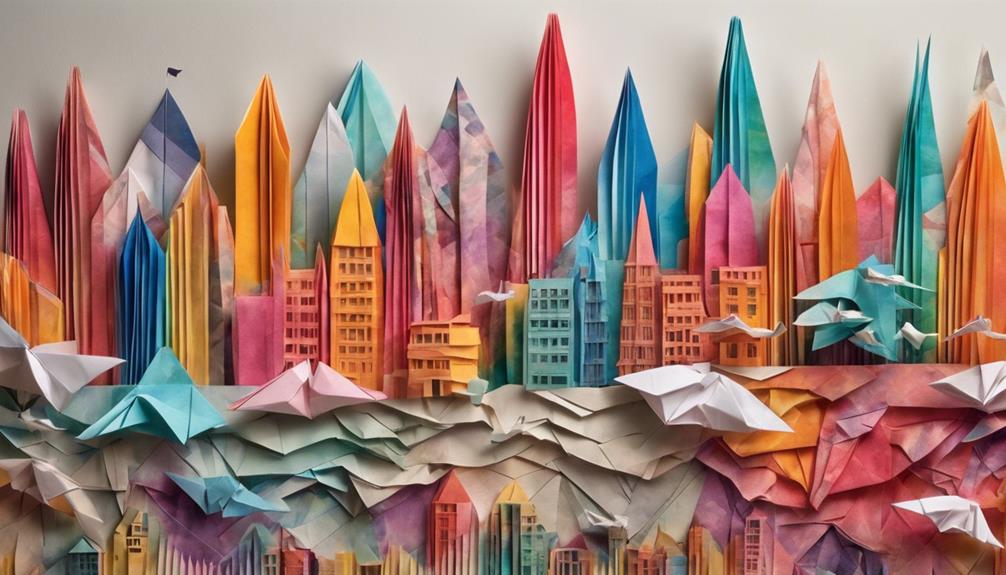Art Nouveau furniture showcases whimsical artistic elements merged with elegant design features. The pieces enchant with nature-inspired motifs like butterflies and leaves, characterized by curvilinear lines and unique construction details. Rococo-inspired storage boasts intricate designs with ornate curves and green glass elements, originating primarily from Europe. Fusion tables blend European-Asian influences, featuring elephant trunk legs and mythical creature motifs like dragons. Handcrafted treasures skillfully blend natural motifs with whimsical elements, telling stories of dedication to the Art Nouveau style. Each piece harmoniously combines functionality with artistic flair, captivating enthusiasts with its creativity and intricate details.
Key Takeaways
- Art Nouveau chairs with curvilinear lines, nature-inspired motifs, and unique construction details for elegant whimsy.
- Ornate Rococo-inspired storage featuring intricate designs, green glass elements, and European origins for a touch of opulence.
- Fusion tables blend European-Asian influences with mythical creatures and romantic carved figures for a harmonious fusion.
- Each piece showcases intricate floral motifs, delicate butterfly designs, and real cherry wood for natural charm and creativity.
- Handcrafted treasures with natural motifs, whimsical elements, and traditional techniques that tell a story of dedication to Art Nouveau.
Unique Art Nouveau Chairs
When exploring Art Nouveau furniture, one immediately notices the charm and allure of unique Art Nouveau chairs. These chairs, often featuring curvilinear lines and nature-inspired motifs like butterflies or leaves, add a whimsical touch to any home decor. One distinctive aspect of Art Nouveau chairs is their asymmetrical designs and unique construction details, enhancing their overall appeal and character. Combining decorative elements with classic French forms, these chairs effortlessly blend elegance with intricate Art Nouveau aesthetics, making them stand out in any room.
Some Art Nouveau chairs go a step further by incorporating whiplash lines and art nouveau motifs, creating pieces that not only exude beauty but also boast a distinctive design language. Whether mass-manufactured or handcrafted, Art Nouveau chairs offer a wide range of options for those looking to infuse their home decor with artistic flair and unique styling. Each chair tells a story of artistry and craftsmanship, making them a captivating addition to any living space.
Ornate Rococo-Inspired Storage

Rococo-inspired storage furniture in the Art Nouveau style showcases intricate designs with ornate curves and linear details. These pieces often feature asymmetrical designs and unique drawer configurations, reflecting the movement's emphasis on intricate details. Green hues are commonly found in the glass elements of Art Nouveau storage furniture, adding a naturalistic touch to the overall ornate designs. While most Art Nouveau storage furniture originates from Europe, some pieces have also made their way to the US, highlighting the style's widespread influence.
To explore further into the ornate Rococo-inspired storage furniture in the Art Nouveau style, the table below showcases some key characteristics and features commonly seen in these pieces:
| Characteristics | Description |
|---|---|
| Intricate Designs | Ornate curves and linear details inspired by Rococo design elements. |
| Asymmetrical Configurations | Unique drawer layouts and asymmetrical designs for a whimsical touch. |
| Green Glass Elements | Commonly used in Art Nouveau storage pieces, adding a naturalistic beauty to the overall design. |
| Origin | Primarily found in Europe with some presence in the US, reflecting the style's European roots and widespread influence. |
| Design Influences | Incorporates various motifs like oak leaves, acorns, and curvilinear aprons, blending eclectic design elements for a whimsical appeal. |
Fusion Tables With European-Asian Influences

Fusion tables with European-Asian influences blend elements from both cultures to create unique and visually engaging pieces. These tables often feature a fusion of design elements from the European Art Nouveau movement and Asian aesthetics, resulting in appealing furniture pieces.
Here are some key characteristics of fusion tables with European-Asian influences:
- Elephant trunk legs or upturned ends add a touch of exotic flair.
- Romantic carved figures and asymmetrical designs typical of European Art Nouveau are often incorporated.
- Look for intricate details that hint at Japanese or Chinese influence but with a Western twist.
- Some tables may showcase mythical creatures like dragons and phoenixes, symbolizing the blend of different cultural aesthetics.
- Fusion tables offer a harmonious fusion of Art Nouveau features with Asian and European design elements, resulting in visually striking and culturally rich pieces.
Creativity and Whimsy in Every Piece

Incorporating intricate floral motifs and nature-inspired designs, Art Nouveau furniture radiates creativity and whimsy in every meticulously crafted piece.
The whimsical nature of Art Nouveau furniture is evident in the delicate butterfly motifs, elegant whiplash lines, and asymmetrical constructions that adorn each piece. These unique details not only showcase the creativity of the designers but also infuse a sense of enchantment into the furniture, making them truly one-of-a-kind.
Art Nouveau furniture seamlessly blends functionality with artistic flair, creating pieces that are both practical and visually enchanting.
The use of real cherry wood without paint adds a natural and organic element to the whimsical designs, further enhancing their charm.
Whether it's chairs, dressers, or tables, Art Nouveau furniture consistently showcases a harmonious blend of creativity and whimsy in every piece, making them a delightful addition to any space seeking a touch of uniqueness and artistic expression.
Handcrafted Art Nouveau Treasures

Artisans skillfully craft handcrafted Art Nouveau treasures, showcasing intricate details and natural motifs such as flowers and vines. These pieces of art deco furniture are characterized by curvilinear lines and asymmetrical designs, reflecting the organic forms found in nature.
When exploring handcrafted Art Nouveau treasures, one may encounter whimsical elements like dragonfly wings or peacock feathers, adding a touch of fantasy to the intricate craftsmanship. The unique furniture pieces are created using traditional woodworking and metalworking techniques, resulting in one-of-a-kind pieces that captivate collectors and enthusiasts alike.
Each handcrafted treasure tells a story of dedication to the art nouveau style, with every curve and detail meticulously considered to evoke a sense of elegance and beauty in the observer's eyes.
Frequently Asked Questions
What Is the Art Nouveau Style of Furniture?
The Art Nouveau style of furniture is characterized by intricate floral motifs, sweeping curves, and nature-inspired designs. This furniture features ornate details, asymmetrical shapes, and a color palette of rich browns, sage green, soft blues, and creams.
Elements like whiplash lines, dragonfly wings, and textured flowers are often incorporated into Art Nouveau pieces. This style can be found in various forms such as chairs, dressers, tables, and storage pieces, blending art and functionality.
How Do You Identify Art Nouveau Furniture?
To identify Art Nouveau furniture, look for:
- Curvilinear lines
- Intricate floral patterns
- Nature-inspired motifs
Key features include:
- Asymmetrical shapes
- Sinuous curves
- Ornate decorative elements like whiplash lines and leaves
These pieces often use rich materials such as:
- Wood
- Stained glass
- Ceramic
In a color palette of:
- Browns
- Sage green
- Blues
- Creams
Unique construction details like:
- Rococo-inspired curves
- Ornate carvings
Reflect the style's:
- Ethereal and natural qualities.
What Is the Difference Between Art Nouveau and Art Deco Furniture?
Art Nouveau furniture is distinguished by nature-inspired motifs and flowing lines, while Art Deco furniture showcases bold, geometric shapes and luxurious materials.
Art Nouveau emphasizes intricate floral patterns and organic forms, reflecting a more ethereal and romantic aesthetic. In contrast, Art Deco furniture features sleek, streamlined designs with a focus on symmetry, sharp angles, and modern materials like chrome and glass.
The former is whimsical and nature-oriented, while the latter exudes glamour and is influenced by the machine age.
What Are Art Nouveau Colors?
Art Nouveau colors, like rich browns, sage green, soft blues, and creams, draw inspiration from nature and organic forms. They harmoniously blend earthy and pastel tones to create an ethereal beauty and natural elegance in pieces.
Imagine a serene garden translated into hues; that's the essence of Art Nouveau colors. These tones evoke a dreamy aesthetic that defines Art Nouveau furniture and decor, infusing spaces with a sense of tranquility and sophistication.
Conclusion
To sum up, the whimsical art nouveau furniture showcased in this article is sure to captivate and delight those with a love for unique and creative design.
With its fusion of European and Asian influences, intricate handcrafted details, and ornate Rococo-inspired elements, each piece offers a touch of elegance and whimsy that will elevate any space.
Embrace the creativity and beauty of Art Nouveau furniture and make a statement in your home today.








